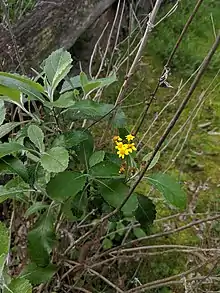| Benambra National Park New South Wales | |
|---|---|
 Benambra National Park | |
| Nearest town or city | Holbrook |
| Coordinates | 35°46′50.1″S 147°05′54.6″E / 35.780583°S 147.098500°E |
| Established | January 2001[1] |
| Elevation | 300–640 m (984–2,100 ft)[2] |
| Area | 13.99 km2 (5.4 sq mi)[3] |
| Managing authorities | NSW National Parks and Wildlife Service |
| Website | Benambra National Park |
| See also | Protected areas of New South Wales |
The Benambra National Park is a protected national park that is located 30 kilometres (19 mi) north-east of Albury, 20 kilometres (12 mi) south-east of Culcairn, and 20 kilometres (12 mi) south-west of Holbrook, New South Wales, in the South West Slopes region of New South Wales, Australia.[3] The park is almost entirely surrounded by private land, however access can be gained by contacting the National Parks & Wildlife Service.
History
Benambra National Park was initially declared a forest reserve in 1879, and in May 1918 it was reclassified as state forest.[4][3] The national park was gazetted in 2001, to protect remnant areas of White Box and Red Box woodlands, which have been extensively cleared across New South Wales.[1] The park has a history of use for grazing and small scale timber harvesting for firewood and fencing.[3]
In 1985 the entire park was burnt, after a lightning strike started a fire north-west of the reserve, which then burnt through park and stopped on a property adjacent to the eastern boundary of the park.[3]
Features
Benambra National Park is situated at the northern end of the Great Yambla Range, a prominent 23 kilometres (14 mi) long outcrop of cliff faces and flat-topped peaks, which forms part of the Lachlan Fold Belt.[3] The park has an altitudinal range between 328 metres (1,076 ft) and 646 metres (2,119 ft) above sea level, covering steeply sloping hills, with only the north-eastern section of the national park being on relatively flat, low-lying country.[3]
A large cave known as 'Morgan's Cave' exists within the park, which was reputedly used in the 1860s as a refuge by the notorious bushranger Dan Morgan.[3]
Access
The park is almost entirely surrounded by private land.[3] There is no public vehicle access to the park, however access to the park for activities such as bushwalking and birdwatching, can be gained by contacting the National Parks & Wildlife Service office in Tumut.[3][1]

Flora
The park comprises several vegetation communities.[5] Red Box-White Box-Dry Shrub Open Forest makes up 69 percent of the park, Red Box-Long-leaved Box Grassy Forest makes up 8 percent, Red Box Swampy Flat Woodland makes up 7 percent, Dwyer's Red Gum-Black Cypress Pine Grass Woodland makes up 5 percent, and 2 percent is Currawang Wattle-Drooping She-oak Shrubland.[5] Woolly ragwort, listed as Vulnerable in NSW under the Biodiversity Conservation Act 2016,[6] occurs within Benambra National Park.[3][5]
Invasive plants found in the park include St. John's wort, Paterson's curse and Tree of Heaven.[3]
Fauna
Threatened birds recorded in the park include Black-chinned honeyeater, Regent honeyeater, Grey-crowned babbler, Hooded robin, Diamond firetail, Painted honeyeater, Swift parrot, Turquoise parrot, Brown treecreeper, and Speckled warbler.[3][5] Threatened mammals recorded in the park include Southeastern long-eared bat, Squirrel glider, Eastern pygmy possum and Yellow-footed antechinus.[3][5] Reptiles found in the park include the Yellow-faced whipsnake.[7]
Several introduced pest species occur, including the European fox, feral goat, feral cat and European rabbit.[3]
See also
References
- 1 2 3 "Benambra National Park". NSW Office of Environment & Heritage. 2022. Retrieved 29 June 2022.
- ↑ Burrows, Geoff E. (1999). "A survey of 25 remnant vegetation sites in the South Western Slopes, New South Wales". Cunninghamia. 6 (2): 283–314.
- 1 2 3 4 5 6 7 8 9 10 11 12 13 14 15 "Benambra National Park and Tabletop Nature Reserve Plan of Management" (PDF). NSW National Parks & Wildlife Service (PDF). Government of New South Wales. October 2004. ISBN 1-74122-0076. Retrieved 29 June 2022.
- ↑ "National Park Estate (Southern Region Reservations) Act 2000- Schedule 1". New South Wales Consolidated Acts. Australasian Legal Information Institute. Retrieved 2 September 2023.
- 1 2 3 4 5 "South West Slopes Region: Benambra National Park & Tabletop Nature Reserve Fire Management Strategy" (PDF). NSW National Parks & Wildlife Service (PDF). Government of New South Wales. May 2005. ISBN 1 74137 340 9. Retrieved 29 June 2022.
- ↑ "Woolly Ragwort - profile". NSW Office of Environment & Heritage. Retrieved 29 June 2022.
- ↑ Michael, Damian; Lindenmayer, David (2010). Reptiles of the NSW Murray catchment: a guide to their identification, ecology and conservation. CSIRO Publishing, Melbourne, Victoria. ISBN 9780643098206.